- You were born in 1975 and will be 31 years old this year. We’re interested to know by what route someone of your generation got into theater? We hear that you came to study at Waseda University in Tokyo from a high school in Hokkaido. Could you begin by telling us something about your high school years? We hear that you used to watch a lot of TV dramas.
- I went to a public co-ed high school and at the time TV dramas were very popular. I watched a lot of the so-called serial dramas, such as Shinji Nojima’s Koko Kyoshi (“High School Teacher”) that had episodes dealing with subjects like forbidden love between teachers and students, incestuous relationships, homosexual relationships and the like. In one season (12 weeks) there would be seven or eight of these dramas going on and I liked them so much that I would record them all on video, from the first episode to the last and watch them all. I don’t know if those dramas are now being reflected directly in my plays today, but they are definitely something close to the core of my thinking. And, the taboo subjects that come out in our Potsudo-ru plays may be partly the influence of those Nojima dramas. Although this is something that is a bit embarrassing to admit.
- Did you watch movies too?
- No. In our area the only movies that came around were the big mass-market films that I wasn’t interested in seeing. I didn’t watch them on videos either. I also wasn’t very interested in amine (animated films), video games or comics. I just liked watching those gritty, everyday-life TV dramas [laughs].
- When was the first time you became involved in theater, and why?
-
In our high school culture festival. For our class skit, they told me to write a play and direct it. At the time, of course, I had no idea that I would be involved in theater in the future. The skit was titled
Edo Jo Kinpatsu-hime Flora
(“Edo Castle Blond-haired Princess Flora”) and was about a theater troupe putting on a chintzy Edo-period play and the mad scramble that happens after a part of the set collapses on the lead character and he is hospitalize, all done in documentary style. It was like a Meta theater piece. We all talked together to decide how it should develop, so you can’t say that it was all my ideas. But, it is interesting that it had something in common with what we are doing today in Potsudo-ru.
At the time, tough, I felt that theater was something un-cool and out of style. And, though it was something un-cool to begin with, it bothered me to be doing an amateurish Read-from-the-script type of skit even for our high school culture festival. Also, the idea that the confusion that occurs after the chintzy play falls apart is more interesting than the play itself … that is an idea that has a lot in common with what we are doing today in Potsudo-ru. I wouldn’t go so far as to call it an outright dislike for conventional theater, but I do feel that we used that as a shield until now. I want to create a platform for us to express ourselves and our lives honesty. And perhaps I have used theater as that platform, then and now. - When and why did you decide to begin doing theater seriously?
-
It was after entering Waseda University. Waseda is a school where student drama is very popular and it was an environment where there was always theater going on around you. I just gradually got drawn into that. The first time that I saw a live drama performance in the closed, intense atmosphere of the small theaters, it had a very strong impact on me. After that I watched the plays by the Waseda theater groups and the popular companies of the day, such as “Caramel Box” and “Nylon 100°C,” and the plays of Suzuki Matsuo’s “Otona Keikaku” company.
Waseda has its venerable Waseda Theater Circle (“Sodai Gekiken”) and I attended a few meetings but found that it wasn’t for me. Instead, I joined the Waseda Drama Club (“Enkura”), which was created by people who had dropped out of the Theatre Circle because they didn’t like its strict discipline. It was a club that didn’t have the strict discipline and was a place where people could do things more freely, which fit my nature better [laughs].
In the Waseda Drama Club, new members go through about three months of physical training and then, after their freshman performance, everyone can do plays as they please. It doesn’t have the unified regimen or solidarity of a theater company. What characterizes the Club most of all was the fact that the different members were doing completely different things. That is what was good about it. - The tenth-term class of that Waseda Drama Club got together and formed the theater company Potsudo-ru and the first play you did was Busaiku (Ugly) – Embracing Your Inferiority Complex (1996), which was said to be strongly influenced by the works of Suzuki Matsuo.
-
I definitely was influenced by Matsuo at the time. He took things like people’s inferiority complexes as a way to bring out visions of human essence. I thought that it was really an achievement the way he made these themes into plays. Nojima also focused on the unseemly sides of people and on society’s taboos. I think the attraction I felt to Matsuo’s plays was a natural extension of those TV dramas [of Nojima] that I was watching with such interest in high school, which is rather embarrassing to admit now [laughs].
Still, in college I didn’t think I would continue to work in theater this long, and I even did the usual job-hunting routine in my senior year quite seriously, though unsuccessfully [laughs]. Getting back to theater, we did our fourth production, which was titled Tsumazeme . Up until that time I had believed in things theatrical to an excess, but suddenly I got tired of it all. For some reason I began to feel embarrassed by it all. So, I decided to try making a film instead of theater. I got together some money to self-produce a movie titled Hatsukoi (First Love). - Hatsukoi is a movie about an ugly young woman named Misaki who also seems to have some physical deformity. She falls in love with a young man named Yoshida who works at a zoo and is constantly bullied and abused by the people around him. All the people who appear in the play are losers of some form or another. In this sense it is similar to many of the plays you have done, but it is quite different from a theatrical work in that most of the screenplay consists of monologue by Misaki. And, unlike the excessive nature of the plays you had done until that time, the movie unfolds in a straight-forward and non-dramatic way.
-
This was a movie that was a film re-creation of a lot of what I had been doing in theater until that time. The spoken lines were written to match the scenes that were filmed, so it isn’t excessive. But, it has elements of what I had been doing with my plays in characters and in the way that the story develops. After doing this movie, I had to do a play again, but I was embarrassed to do the same type of excessive play I had been doing before. What should I do? So I decided to do a work where I stripped away all the theatrical elements, and the result was the play called
Knight Club
.
I decided to do away completely with having the actors raise their voices and deliver lines from a script and all other kinds of impressive theatrical staging techniques. And besides that, I divided Knight Club into two parts. The first part is man’s drama that takes place in a room of an apartment, while in the second part it becomes clear that the first part was actually the drama portion of a soft-porn movie and I make it a documentary style presentation of the action on the movie set when they are just about to film the love-making scenes. I used a situation in which the actors are trying to convince an actress who is really dead set against doing a nude role to undress and do the scene. Since the woman really was extremely reluctant to undress, you get the real emotions of that moment. Still, there was a predictable sense that this was all being faked … . Of course, you lose the natural reactions of the actress being forced to undress when the play is being performed over and over, so I added things like the actress getting beaten in order to keep the natural reaction, because the hurt of being beaten stays the same every time.
In other words, I wanted the “crude emotions” element. I wanted the “reality” that comes when something happens for the first time. My aim was to create the feeling of something that is only happening here and now. Theater is live performance and the only advantage it has over film is that feeling of “liveness,” so I realized that this is the most interesting aspect of theater and if you don’t take advantage of it you are losing something very important. In that sense, you might say that I was doing nothing but returning to the essence of theater. - A lot of your works are produced for small theater performances, with the small theater being a sort of black box rather than a proscenium theater. And it seems to me that your stage settings always involve some sort of frame, like looking through the apartment window in your latest work Yume no Shiro (Castle of Dreams).
-
There is the question of how to share the feeling of “liveness” with the audience. Rather than trying to remove any barrier or separation between the audience space and the performing space, I believe that the more you create a sense of the audience looking down or peeking into the world of the characters on stage from the outside, the more the audience gets into that world and feels like they are a part of it. However, although it is peeking, it is the feeling that you want the person on the other side of the wall to be glued to the peep hole.
With Knight Club I placed several video cameras around the set, and even the curtain was closed between the scenes the audience could watch the action taking place on stage via video monitors on the audience side of the curtain. - Why are you interested in complexes and taboos?
- I myself was always in a relatively privileged environment with a position of advantage when I was growing up, so I was never picked on or bullied and I don’t think I ever had any real complexes. So, I sometimes wonder myself why I continue to deal with people’s unseemly sides and their negative sides [laughs]. So, it may be some kind of denial of how ordinary I am. No, that’s not it either. To tell the truth I don’t really know why [laughs].
- Your next work after Knight Club was Shintai Kensa (Physical Examination).
- When we did Knight Club , the reality achieve by making a play out of physical and emotional reactions and worked out was so interesting to me that I continued to slide in that direction. Shintai Kensa was a radical pursuit of that direction. Knight Club still contained elements of dramatic entertainment, but I thought that in fact those elements were not really necessary at all. I was confident that even without those elements a work could be created that would be interesting to watch.
- What was the work actually like?
-
The first half is set in a sex industry “Nuki-Caba” (a bar/lounge type establishment where the object is for hostesses to service male customers to ejaculation without actual sexual intercourse). Blue-collar workers come to the club and if a customer can win the consent of a hostess, a contract is signed and she takes him to a private room to service him. After showing that process as real action rather than a play for about one hour, all of a sudden it blacks out. During the blackout, we showed a subtitle saying “Seeing this [the first half] is not enough to communicate the intention of this play.” Then we show the rehearsal video, which comes across purely as documentary.
Practically speaking, what I had the actors do was to actually go through actions on the stage that cause them to embarrass themselves and to hurt others and bring out those kinds of negative emotions. The actors take to the stage as individuals, not as actors, and they go through a process of trail and error until they achieve this task. I thought that this process would make an interesting stage to watch.
Also, I thought that it would be best to inform the audience beforehand that what they would be seeing on stage was real action and not a scripted play. So, I wrote on the show’s leaflet “This is a documentary.” This would prepare them to watch what was happening on stage not as fiction but as real events. Since I had told the actors that no faking and no acting was allowed, if the actors hurt other actors, for example, they could no longer use the excuse that it is just acting. So the things that happened, the hurt and such, would remain after the rehearsal and after leaving the stage when the performance is over. This made the things that were happening on stage very close to an actual documentary. In the process, we saw numerous instances of actors talking about their individual traumas and actual personal relationships being revealed, and these were instances that you would never see in an ordinary drama. I have done these documentaries because I want to see these moments of revelation. - Didn’t the actors dislike doing that?
- They did dislike it. But, if the actors showed themselves enjoying doing it, I thought it wouldn’t be interesting for the audience. So the rehearsals were painful. There was trouble that occurred, but we were able to overcome it and bring the show to the stage.
- And the actors endured all that and stayed with it?
- It seems that, because they are actors, they definitely have an inherent desire to show themselves, to embarrass themselves and show their pain and hurt before the audience to a considerable extent, and I think they also accept and appreciate it to a considerable degree when that process becomes a viable stage event worth seeing. Of course, there was also a lot of resentment directed at me.
- After Shintai Kensa you presented the works Make Love and Nettai Video and Otoko no Yume .
-
Make Love
is somewhere half way between a play and a documentary. Because we create a set of a “love hotel” on the stage, this part of it is a lie, unmistakably. But, I had the actors act out their own real emotions, without faking, in that false space. I want to make it clear, however, that this is not an etude, because the actors have been told beforehand that they are forbidden to act. For example, I had an actual couple come out and make love with their true feelings of love for each other, and I had another pair who weren’t a couple yet but were exploring the possibility of becoming lovers and let them go through that frustrating situation with those actual feelings.
With Nettai Video (Tropical Video) I also wanted to explore the documentary possibilities, so I used all kinds of methods from the rehearsal stage. Since the contracts that I used for Shintai Kensa [forbidding actors to withdraw from the production] made it seem like I had the power to work my evil demands on the actors and they essentially came to feel like victims being used by me, I changed to a “letter of intent” by which the actors stated their own intent to participate in the production. I believed this was essential for it all to work, with reality and honesty. From the rehearsal stage the actors resigned themselves to the job they had to do and tried to do their best to make it work, but of course there are limits to what can be done. During the making of Nettai Video some interpersonal problems emerged and some were saying that this was going to be the end of Potsudo-ru. But at the time we were doing these documentaries, we were all poor and struggling to achieve something, and it was also the period when Potsudo-ru was beginning to win some recognition for the first time. So, we had a feeling that we had to go to these kinds of extremes. - Shintai Kensa drew three times the audience you previous works had received.
-
Yes. But at the same time I was worried about the reason behind this attention. To continue that kind of popularity we would have to continue to escalate in terms of the radical-ness of what we were doing because that is what the audience would be expecting. I knew it would be meaningless to just try to answer the audience’s demand for this kind of fare. I realized that if the “scandalous” elements became the draw, people would misunderstand what we were trying to do in the first place.
One of the reasons I stopped the documentary style is my disappointment at this realization. Eventually, what I am interested in was the unavoidable moments when human essence is revealed. So I decided to try as best I could to write these things into a script and do it as fiction. I wrote Otoko no Yume (Every Man’s Dream) for this purpose and deliberately eliminated any scandalous aspect. - In Otoko no Yume and Gekijo (Violent Emotion) that followed it, conversational drama seems to play a much more important role.
-
There is actually about a year and a half between
Otoko no Yume
and
Gekijo
and I think of them as two completely different works. I think
Gekijo
is a work that goes against my nature [as a playwright] more than any other I have done, because I included narration in it and did things like bringing in pieces of storyline.
In Gekijo I think I was interested in the idea that I could create realistic portrayals of people letting out their emotions of anger or sadness and such, and that I could create realistic expressions of emotion even while bringing in strong theatrical elements (narrative, story elements). Since reality I define in this case is a matter of how to depict faithfully people’s communication, I thought that I could overcome the limitations of a strong narrative element by the way I staged the play. - Your work underwent another big change with your next play, Animal .
-
Since I had done a theatrical work with
Gekijo
, I was able to put that issue behind me for a while. Then, while I was thinking about what I wanted to do next, I got an invitation from the Mitaka City Arts Center.
One day I was in a park and I saw some college students talking about something way off in the distance. I was too far away to hear what they were saying but as I watched I realized that I was beginning to understand what they were doing just from their actions and that I naturally came to see the human relations involved, too. In the end, I was able to sit there absorbed in the voiceless action for about an hour. That made me think, “This may make for viable entertainment.” So Animal was a work where I tried to create viable theater just by providing the visual scenes, without dialog or narration. Since we were faced at the time with the problem of whether or not we were capable of doing something in a large theater hall, I thought that this would be the place to try it. - Was there a script?
- I wrote one, but there are some sections where there is no script. In the parts where it was just sufficient if it looked to the audience like the actors are talking I just let them talk about anything they pleased, and then we worked out the scenes in the rehearsal studio. Since the only important thing is the visual aspect of the action, there are many places where it would be meaningless to have the actors speaking actual lines. This was a play where the only thing that mattered was how it looked.
- The characters in Animal are members of the car gangs they call “teamers” in Japan. What made you choose teamers?
- I was not trying to give a realistic portrayal of what teamers are like. The theme of the play was the death of a person. I thought that if I used teamers as the context it could give an interesting accentuation to how light and inconsequential a death can be. It may be a simplistic idea, but if the essence is in the visual action, it is easy to understand and I thought that there would be an interesting contrast between the times when the teamers are playing around and when the death occurs. But, as for the way the teamers act, this is all just from my imagination, so I can’t vouch for its reality in that aspect.
- You won the Kishida Drama Award for Ai no Uzu (Love’s Whirlpool). What do you think about receiving this kind of recognition for its excellence as a play?
-
I was surprised. A lot of the people around me were surprised, too. If you have read it you will know that there are places in the script where it just has a note saying: “Fill in with appropriate conversation” [laughs]. I was surprised that that was enough to communicate something. I think of myself more as a director, so I didn’t expect that kind of recognition as a playwright.
The play Ai no Uzu was rewritten during the rehearsal processes and what was submitted as the play’s text was actually the final stage script, so it contains all the parts that were worked up during the rehearsal process. So I think what was recognized in that award was also the stage directing elements. - In your new work Yume no Shiro (Castle of Dreams) you present a group of contemporary young people gathering in a cluttered one-room apartment, having sex, watching television, playing video games, taking baths, eating and just generally living an undisciplined life. And, finally there is no script at all.
- When I got down to what I really wanted to do … it is movement. Words are just used as a means, with no particular meaning or significance. In Otoko no Yume and Ai no Uzu there was little importance in what the actors were saying, and the focus of the play had slid toward the action. In Animal there were still some parts that weren’t worked out, but in Yume no Shiro I wanted to say that “the message gets across without words and that is the most interesting part.” And, I also thought that eliminating words would be the best way to express the feelings of lassitude and worthlessness of today’s young people and what a bothersome thing communication is to them.
- What do you mean by movement? For example another popular director today among your generation, Toshiki Okada, has found a contemporary dance aspect to the movement and body language of young people today. What does movement mean in your case?
- Okada is very interested in its relationship with the script (disconnection between body movement and dialog, etc.), but in my case I am not really interested in that. In my case it is situation that I am interested in. I make efforts to see how real a situation I can create on stage. And, I am very interested to see what the audience will grasp and imagine from those situations.
- By the way, what does the script for Yume no Shiro look like?
-
There are no written lines or dialog but there directional notes in the script that define all the movements. There are a lot of small noise articulation like that in the play. For example, when there is a movement of “taking out a cigarette” I don’t have them just take out a cigarette but have them pick up the pack of cigarettes once and put it back on the table again to a dropping sound and then have them pick it up again.
I didn’t intend this play to have a particular focus on NEETs or teamers. I just wanted to make use of the revulsion people in the audience would feel from seeing these characters. If you bring these kinds of characters on stage that people can’t identify with, you know that the audience will feel revulsion. Because there they are involved in sexual promiscuity right from the beginning. So, I use that as a starting point. Even so, during the course of the play you see moments that indicate how these characters also have pasts where they have been living normal lives and this causes the audience to gradually begin to identify with them. And, finally I want the audience to feel that they have identified with them. That is what I wanted to do. I don’t portray them as foreign entities that we completely reject. I had a strong desire to portray them as people that we gradually come to feel something in common with. - Listening to you what you say, can we assume that feelings of revulsion are the starting point in many of your plays?
- Yes. Before Ai no Uzu there would often be breakdowns in relationships and the plays would end in feeling of discord. Now that has begun to change. It is not as if I am trying to make concessions to the audience or offer beams of hope or salvation for anyone, it is just that in my own process of thinking out these issues have come to a point where I want people to identify with these characters. It may just be that I have gotten tired of having things disintegrate into hopelessness [laughs].
- In Otoko no Yume you have not only contemporary young people but also an unexpected character (alien) of a different type in the “Yankee” (Japanese expression for young drop-outs like motorcycle gang members with an anti-establishment attitude). But in your works since then it is always the same type of people, with no “alien” characters. That may be why there seem to be almost “utopian” moments in the plays, even if these are not characters who we can feel too sympathetic for. I especially felt this in Yume no Shiro .
- Yes. That is an aspect that is intentional worked into the plays. With regard to Yume no Shiro where I was trying to eliminate words as much as possible, that is one of the extremes of human relations.
- Why can’t this be expressed in words?
- Because I believe that words can be used as routes of escape. I thought that not having any exchange of words might express the desperateness even stronger.
- Is Utopia desperate or hopeless?
- I believe that Utopia and desperation are two sides of the same coin and inseparable.
- The absence of the other is a kind of Utopia, isn’t it.
-
Yes. And that is also a hopeless, desperate state. When I wanted to express that with reality, the answer that I arrived at was non-communication. In fact, during the rehearsal stages of
Yume no Shiro
we were using dialog between the characters, but we were unable to communicate with words, so I removed the dialog completely.
There is something that I want to say with regard to “documentary” works. I believe that there are two kinds of documentary, with one using spoken words as interviews and they like to give impressions that stimulate the viewer’s imagination, and the other is to show real conditions. An example of the latter is like showing scenes of soldiers shooting at each other in war, and it is the latter and the strong sense of involvement it creates that I seek to use. The former is commonly thought of as “quiet theater.” What we are doing is the latter.
I don’t want to use words to stimulate the imagination, I want to leave no room for the imagination, and I want to focus all the attention on what is actually happening on the scene. What is actually happening is everything in our play. What is happening is everything and there is no room at all for literary device. I believe it is this, more than anything, is what characterizes Potsudo-ru. It is up to the audience to decide whether they find this method to be vulgar and unproductive. And I feel that people who think this way will generally show the revulsion they feel with our plays. But that doesn’t bother me.
I also think that the reason my works come out like they do is partly due to the fact that I am a very immediate person and I like things that bring immediate gratification. I don’t really like things that require a complicated process to reach gratification and pleasure. So, part of what I am doing is projecting my own no-good character into the characters in my plays. I think it would be fine if people could just work part-time and go to the red-light district when you wanted, but I can’t live that kind of life myself. In the end, I am just an ordinary person with normal values. Sometimes I ask myself why I am doing these difficult plays and why I continue to try to express these things. - Perhaps you are doing theater because there is a character that is full of desire and a character that regrets its excesses; there is a longing for the character that pursues its desires and a character that regrets doing so.
- Do you think so? All I know is that I have a lot of regrets [laughs].
Daisuke Miura
Desire and Dramaturgy The art of Daisuke Miura, rising star on today’s theater scene
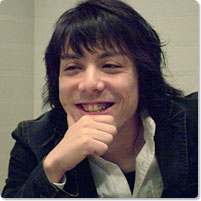
Daisuke Miura
Daisuke Miura was born in Hokkaido in 1975. He is a playwright and director leading the theater unit “Potsudo-ru” formed by members of the 10th class of the Waseda University Drama Club. Having changed from the extremely dramatic plays of the unit’s early years, Miura changed to a style that avoided drama as much as possible in favor of a “semi-documentary” style that sought a high level of “reality.” That style has further progress to the current one that skillfully works a documentary touch into drama to achieve a style that creates “fiction with reality.” Miura’s play
Interviewer: Tadashi Uchino
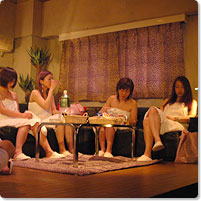
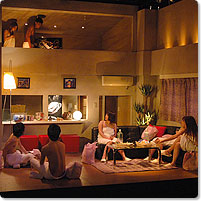
Ai no Uzu(Love’s Whirlpool) won the 50th Kishida Drama Award (2005) after premiering in 2005 as Potsudo-ru’s 13th production.
https://performingarts.jpf.go.jp/en/article/6275/
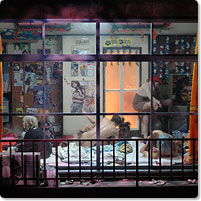
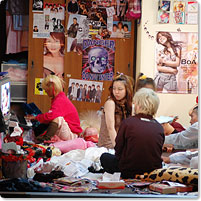
Ai no Uzu(Love’s Whirlpool)
(at Theater Tops, 2005)
Photo: Wakana Hikino
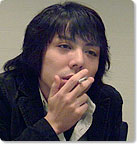
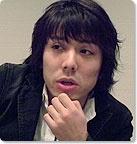
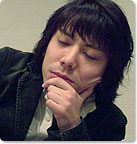
Yume no Shiro
(Castle of Dreams)
(at Theater Tops, 2006)
Photo: Wakana Hikino
Related Tags

